Microbial pathogens, the microscopic viruses, bacteria and fungi that occasionally infect animals, cause disease in the body through four main ways.
The first, and most obvious, is by directly damaging cells, those tiny building blocks that make up the body’s tissues and organs. Viruses and some strains of bacteria need to be inside cells to survive and replicate. Viruses hijack cellular machinery to reproduce and evade the immune system. Then they destroy the cell beyond repair as they bust out and spread to other cells. The body’s immune system also tries to target infected cells and kill them as a sacrifice for the greater good.
Read Also

Quebec pork company calls for transparency around gene-edited pigs
Quebec-based pork company duBreton is calling for transparency around meats from gene-edited pigs on concerns that a lack of mandatory labelling will confuse consumers, and dilute certification claims. The organic sector is also calling for labelling rules.
An example of this direct damage is the virus that causes foot-and-mouth disease. This highly infectious disease is spread between animals by contact or through contaminated surfaces. Affected cattle, sheep, goats and pigs develop severe, painful blister-type lesions on the mouth, lips and hoofs. The virus kills the cells they replicate in, busting out to spread further, and leaving those blisters behind in their wake.
In foals, severe pneumonia and intestinal disease can develop in response to infection by the bacterium Rhodococcus equi. This microbe infects a main type of immune cell and nefariously uses them as a site of replication and sometimes, to spread around the body. The bacterium impedes the immune cell’s normal killing mechanism that would effectively deal with other types of bacteria. The infected immune cells can’t do their job and when the bacteria burst out, the cells die, further contributing to an ineffective immune response.
Second, microbes cause disease in animals through their indirect effects on the body. These include over-responses to infection that aren’t particularly helpful or competent. For instance, scours from certain strains of E. coli in calves involve mild direct damage to the guts. But they stimulate the body to secrete vast amounts of fluid into the intestines, which leads to dehydration and electrolyte imbalances. Often in scouring calves, it is the dehydration that is life-threatening, not the actual intestinal damage itself.
Sometimes the animal responds ineffectively to infections. This is the case with Rhodococcus pneumonia in foals. Because the bacteria use immune cells, the immune system response is curtailed and ineffective. The body tries to contain the infection by forming abscesses, but these don’t succeed in walling off and eliminating the bacteria.
Pathogens also produce harmful products that damage the host in the third broad way microbes cause disease. In this category, a classic example is when bacteria produce toxins. Mannheimia, the bacteria that causes severe pneumonia in feedlot calves, produces a toxin that kills immune cells. This is an effective way to prevent the immune system from dealing with the infection. As mentioned above, some strains of E. coli produce toxins that stimulate over-secretion of fluids into the guts, creating diarrhea and ultimately dehydrating the animals.
The fourth way microbes cause disease is by over-riding the cell’s normal ability to stop dividing. Viruses stimulate cells to proliferate out of control without the normal checks and balances. This over-proliferation is part of how the virus replicates and spreads. An example of this is contagious ecthyma or orf virus. It most commonly infects lambs and kid goats, causing painful mouth sores. If you look closely, these sores are elevated bumps of skin.
The skin is significantly thickened by the virus infection and easily ulcerates and bleeds. It is also prone to secondary bacterial infections.
At the extreme end of this proliferation are cancerous changes. We see this in papillomaviruses that initially cause benign cell proliferation (such as warts in cattle, horses and dogs) but can tip over into cancer given enough time.
These examples of disease-causing strategies underline that pathogens use different means to survive, spread and cause disease. It is through an understanding of these underlying mechanisms that we attempt to diagnose, treat and control disease in animals.
Dr. Jamie Rothenburger, DVM, MVetSc,PhD, DACVP, is a veterinarian who practices pathology and is an assistant professor at the University of Calgary’s Faculty of Veterinary Medicine. Twitter: @JRothenburger

















